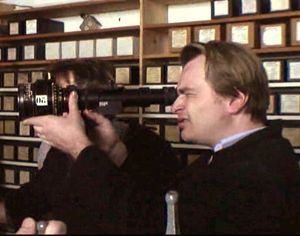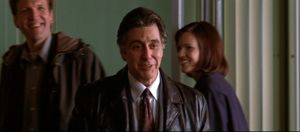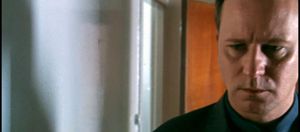Nolan vs. Nolan
2012年诺兰新作《黑暗骑士崛起》热映,大卫·波德维尔在当月19日发表文章,结合诺兰迄今在多部影片中展现的导演技巧,叙事风格,影片主题等元素,旁征博引地进行了“教科书式”的深入而全面的剖析。
本文作者大卫·波德维尔是美国重要的电影理论家,著有多部电影学专著。他与夫人克里斯丁·汤普森合著的《电影艺术-形式与风格》至今已修订再版7次,被公认为电影文化研究的标杆之作。他在广大的电影爱好者以及专业人士心中地位甚高。
克里斯多夫·诺兰是近年来最具票房号召力的导演。在十年前小试牛刀的《记忆碎片》里他便展现了引人入胜的叙事和编导能力,《致命魔术》和《黑暗骑士》等片让他的地位得以巩固,而在2010年创下史上多个票房纪录新高的《盗梦空间》则成就了他的事业巅峰。
2012年诺兰新作《黑暗骑士崛起》热映之际,大卫·波德维尔在当月19日发表了本文,结合诺兰迄今在多部影片中展现的导演技巧,叙事风格,影片主题等元素,旁征博引地进行了“教科书式”的深入而全面的剖析。波德维尔在文中字斟句酌,在许多字句的使用上颇耐人寻味。这篇文章无疑将帮助包括译者在内的众多影迷更全面透彻地理解诺兰的电影,同时对宏观层面上的商业电影文化有更为深入的认识和思考。
DB here:
Paul Thomas Anderson, the Wachowskis, David Fincher, Darren Aronofsky, and other directors who made breakthrough films at the end of the 1990s have managed to win either popular or critical success, and sometimes both. None, though, has had as meteoric a career as Christopher Nolan.
His films have earned $3.3 billion at the global box office, and the total is still swelling. On IMDB’s Top 250 list, as populist a measure as we can find, The Dark Knight (2008) is ranked number 8 with over 750,000 votes, while Inception (2010), at number 14, earned nearly 600,000. The Dark Knight Rises (2012), on release for less than a month, is already ranked at number 18. Remarkably, many critics have lined up as well, embracing both Nolan’s more offbeat productions, like Memento (2000) and The Prestige (2006), and his blockbusters. Nolan is now routinely considered one of the most accomplished living filmmakers.
保罗·托马斯·安德森(《美国导演,作品有《木兰花》,《血色将至》等,译注),沃卓斯基兄弟(《黑客帝国》),大卫·芬彻(《角斗俱乐部》,《12宫杀手》),达伦·阿朗诺夫斯基(《梦之安魂曲》,《黑天鹅》)以及其他的一些导演在上世纪90年代后期都取得了突破,他们要么受大众喜欢,要么被影评人看好,有时候还能两者兼收。不过他们却没有人能像克里斯多夫·诺兰那样,成就如同流星般闪耀迅即的事业崛起。
诺兰的电影在全球票房总收入达到了33亿美元,而且这个数字还在继续攀升。在“IMDB Top 250 List”这样大众化的统计榜单上,《暗黑骑士》(2008)排名第8,共获75万张投票,而《盗梦空间》(2010)排第14名,有近60万张投票。《黑暗骑士的崛起》(2012)仅仅上映一个月不到,就已经排到第18名了。值得一提的是,很多影评人无论是对他早期更为特立独行的作品(诸如《记忆碎片》(2000)和《致命魔术》(2006),还是对其近年拍摄的商业大片,都赞誉有加。现在诺兰俨然被公认为成就最高的在世导演之一。
Yet many critics fiercely dislike his work. They regard it as intellectually shallow, dramatically clumsy, and technically inept. As far as I can tell, no popular filmmaker’s work of recent years has received the sort of harsh, meticulous dissection Jim Emerson and A. D. Jameson have applied to Nolan’s films. (See the codicil for numerous links.) People who shrug at continuity errors and patchy plots in ordinary productions have dwelt on them in Nolan’s movies. The attack is probably a response to his elevated reputation. Having been raised so high, he has farther to fall.
I have only a welterweight dog in this fight, because I admire some of Nolan’s films, for reasons I hope to make clear later. Nolan is, I think all parties will agree, an innovative filmmaker. Some will argue that his innovations are feeble, but that’s beside my point here. His career offers us an occasion to think through some issues about creativity and innovation in popular cinema.
但也有很多影评人非常不待见他的作品。他们认为其电影思想浅薄,剧情粗糙,技巧拙劣。据我所知,近年来还没有哪个商业导演的作品受到过像Jim Emerson和A.D. Jameson对诺兰影片那样尖刻而细致的剖析。那些对于普通影片中出现的叙事不连贯和情节东拼西凑嗤之以鼻的人,同样也能在诺兰的影片中挑刺。他们对于诺兰的抨击或许也是对其声名鹊起的反应。此可谓捧得越高,摔得越重。
如果把这场辩论比作斗狗,那么我牵来的顶多是条中量级的斗犬,这是因为我欣赏诺兰的一些影片,个中原因我希望能随后道明。我想正反各方都认同诺兰是一位有革新精神的导演。有人会说他的革新微不足道,但我想讨论的重点与此无关。诺兰的执导历程让我们得以洞见流行电影文化中关于创意和革新的一些议题。
Four dimensions, at least
四层,至少
(译注:标题似乎略有调侃诺兰影片中的剪辑手法之意,如《盗梦空间》中的四层梦境,详见后文中对“交叉剪辑”的分析)
First, let’s ask: How can a filmmaker innovate? I see four primary ways.
You can innovate by tackling new subject matter. This is a common strategy of documentary cinema, which often shows us a slice of our world we haven’t seen or even known about before—from Spellbound to Vernon, Florida.
首先,我们设问:一个制片人该如何革新?我认为有四种方法。
你可以通过挑战新题材来革新。这是在纪录片中所惯常采用的策略,我们经常在这类影片中看到世界前所未见或者前所未知的一面,从《拼字游戏》(2003)到《弗农,弗罗里达》(1981)等影片都属此列。
You can also innovate by developing new themes. The 1950s “liberal Westerns” substituted a brotherhood-of-man theme for the Manifest-Destiny theme that had driven earlier Western movies. The subject matter, the conquest of the West by white settlers and a national government, was given a different thematic coloring (which of course varied from film to film). Science fiction films were once dominated by conceptions of future technology as sleek and clean, but after Alien, we saw that the future might be just as dilapidated as the present.
Apart from subject or theme, you can innovate by trying out new formal strategies. This option is evident in fictional narrative cinema, where plot structure or narration can be treated in fresh ways. Many entries on this blog have charted possible formal innovations, such as having a house narrate the story action, or arranging the plot so as to create contradictory chains of events. Documentaries have experimented with a film’s overall form as well, of course, as The Thin Blue Line and Man with a Movie Camera. Stan Brakhage’s creation of “lyrical cinema” would be an example of formal innovation in avant-garde cinema.
你也可以通过展现新主题来革新。上世纪50年代的“自由西部片”用“兄弟情义”主题取代了早前西部片中推动情节发展的“命中注定”主题。白人定居者和政府对西部的征服依然是这类影片的题材,但在主题渲染上(当然每部影片略有出入)却有所不同。科幻片曾经充斥着对于未来科技优美光鲜的构想,但当《异形》上映之后,我们发现未来也可能会和当下一样残破不堪。
除了题材和主题,你还可以通过尝试新的形式来革新。这在虚构叙事影片中并不鲜见。在这类影片中,情节的结构安排或者叙事可以用新的手法来处理。在刊载本文的博客上有不少文章都涉及到各种形式革新的可能,比如让一栋房子来作为故事的叙事者,或者安排剧情以便制造一连串矛盾的事件。当然,纪录片同样也对影片的整体形式做过革新实验,比如《细蓝线》和《有摄像机的人》。Stan Brakhage(美国20世纪实验电影先锋导演,译注)所创造的“诗意电影”就是先锋电影中形式革新的例子。
Finally, you can innovate at the level of style—the patterning of film technique, the audiovisual texture of the movie. A clear example would be Godard’s jump cuts in A Bout de souffle, but new techniques of shooting, staging, framing, lighting, color design, and sound work would also count. In Cloverfield and Chronicle, the first-person camera technique is applied, in different ways, to a science-fiction tale. Often, technological changes trigger stylistic innovation, as with the Dolby ATMOS system now encouraging filmmakers to create sound effects that seem to be occurring above our heads.
I see other means of innovation—for instance, stunt casting, or new marketing strategies—but these four offer an initial point of departure. How then might we capture Nolan’s cinematic innovations?
最后你还可以在风格的层面上进行革新 ——通过对电影技巧和影音质感的定型来实现。戈达尔在《精疲力竭》(1960)中的跳接便是一个显著的例子,而在影片摄影,舞台调度,取景,布光,色彩设计以及音效中采用的新技术也可归于其中。影片《苜蓿地》(2008)和《超能失控》(2012)分别用不同的方法,将第一人称视角的摄影技术运用到了科幻叙事中。技术的变革经常能触发风格的革新,比如“杜比全景声”系统(2012年4月24由杜比实验室推出,译注)就促使制片人去创造出从观众头顶上方发出的音效。
当然还有其他革新的手段,比如特技,或者新的营销策略,但上述的四点可以作为我们讨论的出发点。那么我们该怎样理解诺兰的电影革新呢?
Style without style
没有风格的风格
Well, on the whole they aren’t stylistic. Those who consider him a weak stylist can find evidence in Insomnia (2002), his first studio film. Spoilers ahead.
A Los Angeles detective and his partner come to an Alaskan town to investigate the murder of a teenage girl. While chasing a suspect in the fog, Dormer shoots his partner Hap and then lies about it, trying to pin the killing on the suspect. But the suspect, a famous author who did kill the girl, knows what really happened. He pressures Dormer to cover for both of them by framing the girl’s boyfriend. Meanwhile, Dormer is undergoing scrutiny by Ellie, a young officer who idolizes him but who must investigate Hap’s death. And throughout it all, Dormer becomes bleary and disoriented because, the twenty-four-hour daylight won’t let him sleep. (His name seems a screenwriter’s conceit, invoking dormir, to sleep.)
总体来讲诺兰的影片不以风格见长。认为诺兰影片风格不显著的人可以在《失眠症》(2002)中找到佐证,这部影片是他的第一部制片厂影片。下面有剧透。
影片讲述一名洛杉矶警探和搭档来到阿拉斯加的一座小镇上调查一起少女谋杀案。在雾中追逐疑犯的过程中,Dormer开枪误杀了他的搭档Hap,随后他撒谎为自己开脱,试图把搭档之死栽给疑犯。但疑犯,一名作家,却对真相了如指掌,而他的确杀害了那名少女。于是他向Dormer施压,要他嫁祸少女的男友,由此为他们两人开脱。与此同时,Dormer受到了一名年轻警官Ellie的调查,Ellie视Dormer为偶像,但她又必须尽职调查Hap的死因。而在这整个过程当中,Dormer因为极昼导致的失眠,陷入了疲惫而紊乱之中。(主角的名字似乎是编剧的暗喻,意指法语中的dormir,即“睡觉”之意。)
Nolan said at the time that what interested him in the script—already bought by Warners and offered to him after Memento—was the prospect of character subjectivity.
A big part of my interest in filmmaking is an interest in showing the audience a story through a character’s point of view. It’s interesting to try and do that and maintain a relatively natural look.
诺兰曾说该片剧本吸引他的地方在于对于角色的主观性塑造的可能——不过当时华纳公司已经买下了剧本并在《记忆碎片》完成之后交给了他。
我对电影拍摄的兴趣很大一部分在于通过一个角色的视角向观众展现故事。在尝试主观性叙事的同时维持一个相对自然的角度是件有趣的事。
He wanted, as he says on the DVD commentary, to keep the audience in Dormer’s head. Having already done that to an extent in Memento, he saw it as a logical way of presenting Dormer’s slow crackup.
But how to go subjective? Nolan chose to break up scenes with fragmentary flashes of the crime and of clues—painted nails, a necklace. Early in the film, Dormer is studying Kay Connell’s corpse, and we get flashes of the murder and its grisly aftermath, the killer sprucing up the corpse.
他在影片DVD附带的导演评论中说他想把观众置于Dormer的头脑中。而在一定程度上,诺兰已经在《记忆碎片》中施展了这一招,而他认为用这种方法来展现Dormer逐渐走向精神崩溃也是合乎逻辑的。
但如何展现主观性呢?诺兰选择的方法是将场景分解为行凶场面和各种线索的快闪片断,比如涂抹过的指甲,一串项链。在影片开始不久后的一幕,Dormer在查看Kay Connell的尸体,观众同时也看到谋杀案的片断,以及随后凶手整理尸体的悚然片断。
At first it seems that Dormer intuits what happened by noticing clues on Kay’s body. But the film’s credits started with similar glimpses of the killing, as if from the killer’s point of view, and there’s an ambiguity about whether the interpolated images later are Dormer’s imaginative reconstruction, or reminders of the killer’s vision—establishing that uneasy link of cop and crook that is a staple of the crime film.
Similarly, abrupt cutting is used to introduce a cluster of images that gets clarified in the course of the film. At the start, we see blood seeping through threads, and then shots of hands carefully depositing blood on a fabric (above). Then we see shots of Dormer, awaking jerkily while flying in to the crime scene. Are these enigmatic images more extracts from the crime, or are they something else? We’ll learn in the course of the film that these are flashbacks to Dormer’s framing of another suspect back in Los Angeles. Once again, these images get anchored as more or less subjective, and they echo the killer’s patient tidying up.
一开始这似乎是Dormer凭直觉通过Kay尸体上的线索来重现犯罪过程。但影片在报幕伊始就有类似的凶杀片断,似乎是从凶手的视角进行呈现,因此随后我们看到的片断究竟是Dormer想象中的犯罪重现还是凶手脑海里的残像,在这一点的判断上就显得模棱两可了。而籍此诺兰搭建起了警察和歹徒之间的联系,这也是犯罪类型片着力描绘的部分。
不连贯剪辑同样也被用在影片过程呈现一组逐渐明朗的影像。在影片开头,我们看到血浸过床单,接下来的几个镜头里我们看到有人用手仔细将血放到一块布料上。之后我们看到Dormer在飞往犯罪现场的飞机上惊醒的镜头。这些迷一般的影像究竟是犯罪现场的还原片断,还是另有其意呢?随着影片的进行,我们将发现这些片断其实是Dormer脑海里对他在洛杉矶设计栽赃另一名嫌犯的闪回片断。再一次,这些影像的呈现多少带有主观性,并和凶手细心清理现场的片断相呼应。
Nolan’s reliance on rapid cutting in these passages is typical of his style generally. Insomia has over 3400 shots in its 111 minutes, making the average shot just under two seconds long. Rapid editing like this can suit bursts of mental imagery, but it’s hard to sustain in meat-and-potatoes dialogue scenes. Yet Nolan tries.
In lectures I’ve used the scene in which Dormer and Hap arrive at the Alaskan police station as an example of the over-busy tempo that can come along with a style based in “intensified continuity.” In a seventy-second scene, there are 39 shots, so the average is about 1.8 seconds—a pace typical of the film and of the intensified approach generally.
总体说来,在这些里影片片段里,诺兰的典型风格就体现在他所依赖的快速剪辑上。《失眠症》在111分钟里有3400个镜头,平均每个镜头长度不足2秒。这样的快速剪辑适合用来呈现迸发的心理意象,但却很难用来交代最基本的对话场景。不过诺兰还是做了尝试。
在平时的讲课中,我用了本片中Dormer和Hap到达阿拉斯加警察局的那一幕,将其作为基于“紧凑连续剪辑”之上的超快节奏风格的一个示例。影片中一个长达70秒的场景包含了39个镜头,平均每个镜头有1.8秒,这是本片的典型节奏,也是这类紧凑剪辑手法的典型节奏。
Apart from one exterior long-shot of the police station and four inserts of hands, the characters’ interplay is captured almost entirely in singles—that is, shots of only one actor. Out of the 34 shots of actors’ faces and upper bodies, 24 are singles. Most of these serve to pick up individual lines of dialogue or characters’ reactions to other lines. The singles are shot with telephoto lenses, a choice exemplifying what I called the tendency toward “bipolar” lens lengths in intensified continuity–that is, either very long lenses or fairly wide-angle ones.
除了一个展现警察局全貌的外部长镜头和四组手部特写镜头,这一幕中角色的互动几乎全部用单镜头交代,就是说每个镜头里面只有一名演员。在34个演员的脸部以及上半身的镜头里,有24个单镜头。这些镜头大多用来展示单个角色的对白或是角色的回应对白。这些单镜头使用长焦镜头拍摄的,这种选择也可以佐证我以前曾提到的在“紧凑连续剪辑”中镜头选择的“两极化”趋势,也就是说要么采用长焦距镜头,要么采用广角镜头进行拍摄。
Fast cutting like this need not break up traditional spatial orientation. In this scene, there are a couple of bumps in the eyeline-matching, but basically continuity principles are respected. As Nolan explains on the DVD commentary, he tried to anchor the axis of action, or 180-degree line, around Dormer/Pacino, so the eyelines were consistent with his position, and that’s usually the case here.
The scene’s development and the actors’ line readings are emphasized by the cutting; the lighting and framing remain almost unvarying (though there’s also an occasional slight push-in during an establishing framing). These aren’t innovative choices, having become conventional, gradually but firmly, since the 1970s.
像这样的快速剪辑无需打破传统的空间定位。在这幕中,镜头间角色在视线顺接上有些不连贯,但基本上遵守了连续性原则。诺兰在DVD附带评论里说他试图围绕Dormer/Pacino来安排动作线/180度线,以确保角色间的视线关系和主角的位置相对应,这一幕中的镜头关系基本如此。
这一幕的情节发展和演员的对白通过剪辑得到强调;布光和取景几乎保持不变(虽然在定位镜头中偶尔会有一些细微的推进)。这些拍摄手法算不上革新,自从上世纪70年代起就已经逐渐成为了常规手法。
I can’t illustrate all the shots here, but despite its more or less cogent continuity, the scene seems to me choppy, uneconomical, and fairly perfunctory in its stylistic handling. Nolan makes no effort to move the actors around the set in a way that would underscore the dramatic development. Because of the rapid editing, characters’ lines and gestures are cut off or unprepared for. There is no effort to design each shot, à la Hitchcock, to fit the line or reaction of the actor. Most shots are excerpted from full takes, all from the same setup. The most obvious example is the setup that pans to show Dormer as he comes in, stops, and reacts to the conversation. Thirteen shots are taken from that setup (not necessarily the same full take, of course, as the last frame here shows).
我无法在此展示所有的镜头,而这一幕的连续性虽然让人信服,但在风格上的处理我觉得显得零碎,不够简洁并且颇为草率。诺兰没有花太大功夫通过调度演员来强调戏剧化发展。因为快速剪辑的原因,角色的台词和动作要么被切断,要么显得准备不足。诺兰没有像希区柯克那样,设计每个镜头以配合演员的对白或反应。大多数镜头都是从使用同一个布景的拍摄片断中剪辑得来。最显著的例子就是一个展现Dormer入场,停下,加入谈话中的镜头布景。在这个布景中共有13个镜头(当然并非全部都是从单次镜头拍摄中剪切出来,从上面的最后一个镜头就可以看出)
In Nolan’s recent films, this avoidance of tightly designed compositions may be encouraged further because he’s shooting in both the 1.43 Imax ratio and the 2.40 anamorphic one. There remains a general tendency toward loose, roughly centered framings.
Somebody is sure to reply that the nervous editing is aiming to express Dormer’s anxiety about the investigation into his career. But that would be too broad an explanation. On the same grounds, every awkwardly-edited film could be said to be expressing dramatic tensions within or among the characters. Moreover, even when Dormer’s not present, the same choppy cutting is on display.
诺兰在近年拍摄的影片中回避仔细安排镜头间关系的做法或许是因为他拍摄的影片既有1.43:1的Imax屏幕比例也有2.40:1的全屏幕比例。而这两者间折中的拍摄选择就是往松散,不居中的取景方式靠拢。
有人肯定会说这种紧张的剪辑是为了展现Dormer对于他自己遭遇的调查感到焦虑。但这种解释太过空泛。按照同样的逻辑,每一部被剪辑得很狼狈的影片都可以用“表现演员自身或演员之间戏剧张力”来作为托词。更有甚者,即使Dormer不在场时,影片中同样也有零碎的剪辑。
Consider the 23 shots showing Ellie greeting Dormer and Hap as they get off the plane. Again we have full production takes broken up into brief phases of action (it takes five shots to get Dormer out of the plane), with an almost arbitrarily succession of shot scales. When Ellie leaves her vehicle to go out on the pier, the action is presented in nine shots.
再来看看Ellie迎接Dormer和Hap下飞机时的23个镜头。我们再次看到几个连续的拍摄段落被分解成了简短的动作片断(Dormer下飞机就用了5个镜头),而片断之间的镜头焦距变化几乎是随意的。Ellie下了车走到码头的一幕,整个动作用了9个镜头。
We can imagine a simpler presentation—perhaps after an establishing shot, we track with Ellie down along the dock (so we can see her smiling anticipation), then pan with her walking leftward into a framing that prepares for the plane hatch to open. Arguably, the need to show off production values—the vast natural landscape, the swooping plane descending—pressed Nolan to include some of the extra shots. They don’t do much dramatically, and the strange cut back to an extreme long-shot (to cover the change to a new angle on Ellie?) may negate whatever affinity with her that the closer shots aim to build up.
我们可以设想一个更简单的呈现方式—或许在一个定位镜头之后,我们一路跟拍Ellie走到码头(从而我们可以看到她面露微笑期待偶像的到来),接着镜头随她往左横摇进入一个静止景框,随后可以从中看到开启的飞机舱门。当然向观众炫耀制作成本的必要——广袤的自然风光,水上飞机滑翔降落等场景,促使诺兰加入了一些多余的镜头。但这些镜头并没有什么戏剧效果,而且一个到远距镜头的回切(以此来掩盖Ellie在镜头里的角度变化?)却足以抵消之前中近镜头试图对她建立的任何亲切感。
Swedish sleeplessness
瑞典式失眠
(译注:瑞典导演的失眠场面处理)
《神奇的迈克》剧照
Want an up-to-date comparison? Steven Soderbergh’s Magic Mike has a quiet, clean style that conveys each story point without fanfare. Soderbergh saves his singles for major moments and drops back for long-running master shots when character interaction counts. His cuts are just that; they trim fat. He doesn’t resort to those short-lived push-in camera movements that Nolan seems addicted to. He doesn’t waste time with filler shots of people going in and out of buildings, or aerial views of a cityscape. Soderbergh can provide an unfussy 70s-ish telephoto long take of Mike and Brooke walking along a pier and settling down at a picnic table in front of a Go-Kart track while her brother Adam materializes in the distance. In a single year, with Contagion, Haywire, and Magic Mike, Soderbergh has confirmed himself as our master of the intelligent midrange picture. To anyone who cares to watch, these movies give lessons in discreet, compact direction.
For a more pertinent contrast case, we can go back Insomnia’s source, the 1997 Norwegian film of the same name written and directed by Erik Skjoldbjaerg. Here a Swedish detective, vaguely under suspicion for an infraction of duty, comes to a town on the Arctic Circle for a murder investigation. The plot is roughly similar in its premise, but the working out is quite different, and I can’t do justice to it here. Let me mention just two points of contrast.
拿眼下其他导演的作品来作个比较如何?Steven Soderbergh(译注:美国导演,凭借《贩毒网络》获得2000奥斯卡最佳导演奖)的《神奇的迈克》有着安静,简洁的风格,其中的每个情节要点的都没有被大势渲染。Soderbergh只在一些重要的时刻使用单镜头叙事,而在角色互动的场景里又用回了主镜头。这就是他的剪辑方式;不留臃肿。他没有采用那种短促的推进式镜头,对此诺兰倒是乐此不疲。他没有用诸如人们走进走出建筑或是城市的航拍等填充镜头来浪费时间。Soderbergh可以用一个70年代常见的长焦长镜头来展现Mike和Brooke沿着码头一直走到Go-Kart外面的野餐桌前,而她的弟弟逐渐从远方走来。Soderbergh凭借一年里推出的三部作品:《传染病》,《致胜一击》和《神奇的迈克》向我们证明了他是中等成本情节片的大师。这三部电影像我们展现了低调而简洁的导演技巧。
如果要做一个更贴切的对比,我们可以回到《失眠症》的源头,1997年由挪威导演Erik Skjoldbjaerg编写并执导的同名影片。在本片中,一位被怀疑有渎职行为的瑞典警探,来到了位于北极圈中的一座小镇调查一起谋杀案。两部影片的情节大致类似,但展现的手法却大不相同,而在本文中无法对此做全面分析。我只想提及两个不同点。
First, the cutting is less jagged. Skjoldbjaerg’s film comes in at ninety-seven minutes, about fifteen minutes shorter than Nolan’s, and its cutting rate is much slower, around 5.4 seconds. That means that many passages are built out of sustained shots, particularly ones showing the detective Jonas Engström walking or sitting in a brooding, self-contained silence. Also, this version finds ways to convey several bits of information concisely, in carefully designed shots. For a straightforward example: We see Engstrom’s eyes open, as he’s unable to sleep, and then he lifts his head. Rack focus to the clock behind him.
首先,原版影片的剪辑更为流畅。Skjoldbjaerg的版本时长97分钟,比诺兰的版本短了约15分钟,而原版里的剪辑频率也要比诺兰版本慢了不少,大概平均每个镜头耗时5.4秒。这就意味着许多片断是由连贯的镜头构成的,特别是展现警探Jonas Engström坐立不安,若有所思,沉默不语的那些镜头。而且原版影片通过仔细设计的拍摄镜头,以颇简练的方式向观众传达信息。举个最直接的例子:我们看到Engstrom睁着双眼,无法入睡,而当他抬起头以后,画面聚焦到了他身后的电子钟。
Nolan uses several shots to get across a comparable point.
诺兰则用了数个镜头来表达同样的内容。
As for subjectivity, Skoldbjaerg is just as keen to get us inside his detective’s head as Nolan is. At times he uses the sort of flash-cutting Nolan employs, so we get fragmentary reminders of the fog-clouded shooting. But Skoldbjaerg doesn’t tease us with unattributed inserts (Nolan’s flashbacks to Dormer’s framing of a suspect), and he never suggests, via images of the murder and its cleanup, that his detective can imagine the crime concretely. Instead, Skoldbjaerg often evokes his character’s unease through camera movements that upset our sense of his spatial location. The camera shows Engstrom striding into a room…and then swivels rightward to show him in his original location, as if he’s sneaked around behind our back.
而在主观性这一点上,Skoldbjaerg和诺兰一样,迫切想把我们拉进侦探的头脑中。片中他有几次也像诺兰那样使用了闪回的剪辑来向我们呈现雾中枪击的片断。但是Skoldbjaerg没有用指向不明的片断来吊我们胃口(比如诺兰片中Dormer对另一起案件中设计嫌犯的闪回),而且他从来没有通过谋杀案的画面和善后清理的镜头来暗示侦探能切实想象出谋杀过程。Skoldbjaerg转而籍由调度片中主角在画面中的位置来呈现出令观众不安的观感,并由此让观众感受到主角的不安情绪。(如下图)镜头中Engstrom走进了一个房间…接着镜头向右摇转展现他站在最初的位置,仿佛他悄然走到了我们观众的背后。
Then Engstrom turns, and we hear a footstep. Cut to a shot showing that the sound is made by him, walking in another room.
接着接着Engstrom转过身,然后我们听到了脚步声。影片跳到下一个镜头,我们看到这是他在另一个房间踱步发出的声音。
I’m not going to suggest that Skoldbaerg innovates more radically than Nolan does, though most viewers probably are more startled by these devices than by Nolan’s. I think that the original Insomnia’s stylistic gamesmanship owes something to other precedents, going back to Dreyer’s Vampyr. What I find more interesting is that Nolan had available the prior example of these strategies from his Nordic source, and he still chose to go with the more conventional, cutting-based options.
The editing-driven, somewhat catch-as-catch-can approach to staging and shooting is clearly Nolan’s preference for many projects. He doesn’t prepare shot lists, and he storyboards only the big action sequences. As his DP Wally Pfister remarks, “What I do is not complicated.” Comparing their production method to documentary filming, he adds: “A lot of the spirit of it is: How fast can we shoot this?”
我不会因此就表示相比起诺兰,Skoldbjaerg所做的革新更为极端,即便对比起诺兰的快剪手法,大多数观众或许会更惊讶于Skoldbjaerg在此的呈现方式。我认为原版《失眠症》在风格上的高明把控也借鉴了其他的电影前辈,早至Dreyer的《吸血鬼》(1932)。更让我感兴趣的是诺兰在北欧原版影片中可以借鉴到这些拍摄方法,但他仍然选择了更为常规,基于后期剪辑的表现形式。
诺兰在很多影片中显然更喜欢运用这种依赖剪辑,有点像瞎猫逮死耗子(catch-as-catch-can)的手段来进行场面调度和影片拍摄。他不会事先准备拉片分镜表,而他只会为一些大场面的场景准备故事板。正如他的摄影导演Wally Pfister所言,“我要做的事情并不复杂。”Wally把他们的摄制方法与纪录片拍摄做类比,他还说:“其中的主导思想在于:我们多块能拍完?”
Throwing it against the wall
往墙上扔过去
We can find this loose shooting and brusque editing in most of Nolan’s films, and so they don’t seem to me to display innovative, or particularly skilful, visual style. I’m going to assume that his strengths aren’t in the choice of subjects either, since genre considerations have kept him to superheroics and psychological crime and mystery. I think his chief areas of innovation lie in theme and form.
The thematic dimension is easy to see. There’s the issue of uncertain identity, which becomes explicit in Memento and the Batman films. The lost-woman motif, from Leonard’s wife in Memento to Rachel in the two late Batman movies, gives Nolan’s films the recurring theme of vengeance, as well as the romantic one of the man doomed to solitude and unhappiness, always grieving. If this almost obsessive circling around personal identity and the loss of wife or lover carries emotional conviction, it owes a good deal to the performances of Guy Pearce, Hugh Jackman, Christian Bale, and Leonardo DiCaprio, who put some flesh on Nolan’s somewhat schematic situations.
在诺兰大多数影片中,我们都能看到到这种松散的拍摄手法和唐突的后期剪辑,因此在我看来,这些都没有展现出革新的或者是特别有技术含量的视觉风格。我猜想他的强项也不在题材的选择上,他拍摄的影片主要是超级英雄,心理犯罪以及悬疑这样的类型。我认为他革新的主要领域在于影片的主题和形式。
诺兰影片的主题层面不难考察。其中包含“身份不明”的话题,这在《记忆碎片》和《蝙蝠侠》系列中显而易见。“缺失的女人”这个主旨,从《记忆碎片》中Leonard的妻子到前两部《蝙蝠侠》影片中的Rachel,使得诺兰影片一再出现复仇主题,以及男主角注定孤独悲伤这种浪漫主题。如果说这种对于个人身份近乎痴迷的纠缠以及爱人缺失的主题在情感上能让观众认同,那也要多亏Guy Pearce, Hugh Jackman, Christian Bale以及Leonardo DiCaprio等明星的演技,他们让诺兰这种按部就班的影片场景变得鲜活。
You can argue that these psychological themes aren’t especially original, especially in mystery-based plots, but the Batman films offer something fresher. The Dark Knight trilogy has attracted attention for its willingness to suggest real-world resonance in comic-book material. Umberto Eco once objected that Superman, who has the power to redirect rivers, prevent asteroid collisions, and expose political corruption, devotes too much of his time to thwarting bank robbers. Nolan and his colleagues have sought to answer Eco’s charge by imbuing the usual string of heists, fights, chases, explosions, kidnappings, ticking bombs, and pistols-to-the-head with sociopolitical gravitas. The Dark Knight invokes ideas about terrorism, torture, surveillance, and the need to keep the public in the dark about its heroes. Something similar has happened with The Dark Knight Rises, leaving commentators to puzzle out what it’s saying about financial manipulation, class inequities, and the 99 percent/ 1 percent debate.
Nolan and his collaborators are doubtless doing something ambitious in giving the superhero genre a new weightiness. Yet I found The Dark Knight Rises, like its predecessor, unable to bear the burden. It seemed to me at once pretentious and confused in a manner typical of Hollywood’s traditional handling of topical themes.
你也可以找茬说这些心理主题不是格外具有原创性,尤其是那些基于悬疑的情节,不过《蝙蝠侠》系列倒有些新意。《暗黑骑士》三部曲吸引人的地方在于以漫画故事的素材来呼应现实世界。Umberto Eco(意大利著名学者,小说家,评论家,译注)曾经就质疑说像超人能力惊人,他能改变河流流向,避免地球遭受陨石撞击,揭发政治腐败,但他却花了太多时间来对付银行抢劫犯。似乎是为了回应Eco的指摘,诺兰和同事们把影片中一连串平淡无奇的抢劫,打斗,追逐,爆炸,绑架,炸弹倒计时,头顶枪口的场面再掺入了社会政治层面的沉重感。《暗黑骑士》让人思索恐怖主义,虐待,监视以及幕后英雄不必为人知晓等话题。而在《暗黑骑士的崛起》中类似的思考同样被勾起,让一众评论家去纠结影片关于金融操控,阶级不平等以及99%/1%财富分配这些问题究竟想表达什么。
诺兰和他的合作者们无疑在超级英雄类型片中野心勃勃地加入了新的砝码。不过我认为《暗黑骑士的崛起》和系列前作一样,无力承载过重的意指。我很快就感觉了其中装腔作势,含混不清的呈现方式,这也是好莱坞在处理这类话题性主题时的典型而传统的方法。
The confusion comes into focus when journalists, needing an angle on this week’s release, look for a coherent reflection of that elusive, probably imaginary zeitgeist. I think that most popular films don’t capture the spirit of the time, assuming such a thing exists, but simply opportunistically stitch together whatever lies to hand. Let me recycle what I wrote four years ago.
I remember walking out of Patton (1970) with a hippie friend who loved it. He claimed that it showed how vicious the military was, by portraying a hero as an egotistical nutcase. That wasn’t the reading offered by a veteran I once talked to, who considered the film a tribute to a great warrior.
这种含义不明,令人理解混乱的情况凸显在记者们对影片各自不一的解读。他们都需要琢磨出影片中那令人迷惑,甚至或许只存在于想象中的时代精神,从而能写出本周影评。如果时代精神真的存在,那我认为绝大多数大众电影都没有将其把握—这些电影不过是投机地把手中的话题拼凑到一块。让我来看看自己四年前写的东西。
我记得和一位嬉皮朋友看完《巴顿》后走出影院。他喜欢这部影片,认为影片通过刻画一个自我主义的顽固派英雄,表现了军队的丑恶。但当我和一位退役老兵谈到该片时,他的观感却不尽相同,他认为影片是向一名伟大的战士致敬。
It was then I began to suspect that Hollywood movies are usually strategically ambiguous about politics. You can read them in a lot of different ways, and that ambivalence is more or less deliberate.
A Hollywood film tends to pose sharp moral polarities and then fuzz or fudge or rush past settling them. For instance, take The Bourne Ultimatum: Yes, the espionage system is corrupt, but there is one honorable agent who will leak the information, and the press will expose it all, and the malefactors will be jailed. This tactic hasn’t had a great track record in real life.
从那时起我开始怀疑好莱坞电影通常策略性地把其政治倾向模糊化。你可以从不同角度来解读,而这种含混暧昧或多或少是刻意为之的。
好莱坞电影倾向于呈现出尖锐的道德两极,然后又语焉不详,或者回避讨论,或者草草结尾。拿《伯恩身份3》来举个例:没错,间谍系统是腐败的,但还是有一个品行高尚的特工愿意透露出内幕,而媒体也会将其全部曝光,然后坏人会被抓进监狱。但在真实世界里,这名特工的选择可不会有什么好结果。
The constitutive ambiguity of Hollywood movies helpfully disarms criticisms from interest groups (“Look at the positive points we put in”). It also gives the film an air of moral seriousness (“See, things aren’t simple; there are gray areas”). . . .
I’m not saying that films can’t carry an intentional message. Bryan Singer and Ian McKellen claim the X-Men series criticizes prejudice against gays and minorities. Nor am I saying that an ambivalent film comes from its makers delicately implanting counterbalancing clues. Sometimes they probably do that. More often, I think, filmmakers pluck out bits of cultural flotsam opportunistically, stirring it all together and offering it up to see if we like the taste. It’s in filmmakers’ interests to push a lot of our buttons without worrying whether what comes out is a coherent intellectual position. Patton grabbed people and got them talking, and that was enough to create a cultural event. Ditto The Dark Knight.
好莱坞电影这种观点构成上的模棱两对其消解来自各利益团体的批评倒是大有裨益的。(“看吧,我们在里面也加入了正面内容的哦”)。这种含混还让影片有一种道德上的严肃感(“看嘛,事情没那么简单;还有些灰色地带呢”)。
我不是说电影不能传递一些意味明确的信息。Bryan Singer和Ian McKellen就认为《X战警》系列批评了对于同性恋和少数群体的歧视现象。我也不认为如果一部电影观点模糊,就是因为制作人刻意植入了各种相互制衡的信息。有时他们可能会这么做。更多的时候我觉得电影制作者们是投机地把各种文化符号搅到一块然后端出来,看大家是否喜欢。能勾起我们观众的各种想法,又不用考虑其观点立场是否连贯同意,电影制作者们肯定是乐于此道的。《巴顿》吸引了各种观众并引发了他们的讨论,这就足以制造一次文化事件。现在的《暗黑骑士》也是如此。
Since I wrote that, Nolan has confirmed my hunch. He says of the new Batman movie:
We throw a lot of things against the wall to see if it sticks. We put a lot of interesting questions in the air, but that’s simply a backdrop for the story. . . . We’re going to get wildly different interpretations of what the film is supporting and not supporting, but it’s not doing any of those things. It’s just telling a story.
我当时这么写道,而今诺兰映证了我的猜测。他自己对新蝙蝠侠影片的看法如下:
我们把很多元素扔到墙上,看他们能不能粘上去。我们提出了很多有趣的问题,但这只是影片的故事背景…关于影片支持什么,反对什么,我们会得到很多迥异的解读,但电影本身并不参与其中。电影只是讲个故事。
Just to be clear, I don’t think the just-telling-a-story alibi is bulletproof. The cultural mix on display in a movie can still exclude certain ideological possibilities, or frame the materials in ways that slant how spectators take them up. My point is only that we ought not to expect popular movies, or indeed many movies, to offer crisp, transparent visions of politics or society. Thematic murkiness and confusion are the norm, and the movie’s inconsistencies may reflect nothing more than the makers’ adroit scavenging.
确切地说,我不认为“只为了讲故事”这种托词是无懈可击的。一部影片中的文化大杂烩仍然会排除某些意识形态上的可能性,或者素材选择的范围也会影响观众的解读。我的观点只不过是我们不应该指望大众电影,或者说包括大众电影在内的很多电影,能对于政治或者社会提出清晰,明确的观点。主题上的模糊含混是很寻常的,而影片缺乏连贯性也不过是反映了制作者机灵到了来者不拒的程度。(原文为adroit scavenging,前者为聪明机智,后者意指从垃圾堆里捡东西,饥不择食,Bordwell对诺兰的奚落可见一斑,译注)
Subjectivity and crosscutting
主观性和交叉剪辑
Nolan’s innovations seem strongest in the realm of narrative form. He’s fascinated by unusual storytelling strategies. Those aren’t developed at full stretch in Insomnia or the Dark Knight trilogy, but other films put them on display.
One way to capture his formal ambitions, I think, is to see them as an effort to reconcile character subjectivity with large-scale crosscutting. Nolan has pointed out his keen interest in both strategies. But on the face of it, they’re opposed. Techniques of subjectivity plunge us into what one character perceives or feels or thinks. Crosscutting typically creates much more unrestricted field of view, shifting us from person to person, place to place. One is intensive, the other expansive; one is a local effect, the other becomes the basis of the film’s enveloping architecture.
诺兰的各项革新似乎在叙事形式领域最显著。他着迷于与众不同的叙事方式。在《失眠症》和《暗黑骑士》三部曲中,他的叙事手法未能得以全面展现,但是在其他作品中有所体现。
要理解诺兰在形式上的雄心壮志,我觉得不妨将其看作是他为了调和主观性叙事和大规模交叉剪辑所做的努力。诺兰对两者都展现出了强烈的兴趣。但乍看起来,这两者却是相互对立的。主观性叙事的技巧把观众推进影片角色的视角或者思维出发点。而交叉剪辑则典型地被用来制造更自由的视角,让观众在不同角色和不同场景间游走。前者是集中视角,后者是发散视角;一面是局部效果,另一面却是包裹整部影片的基础。
The Batman trilogy has plenty of crosscutting, but as far as I can tell, subjectivity takes a back seat. Nolan’s first two films reconcile subjectivity and crosscutting in more unusual ways. Following takes a linear story, breaks it into four stretches, and then intercuts them. But instead of expanding our range of knowledge to many characters, nearly all the sections are confined to what happens to one protagonist, and they’re presented as his recounted memories in a Q & A situation.
Likewise, Memento confines us to a single protagonist and skips between his memories and immediate experiences. Again what might be a single, linear timeline is split, but then one series of incidents is presented as moving chronologically while another is presented in reverse order. Again, the competing time trajectories aren’t presented as large blocks but are fairly swiftly crosscut.
《蝙蝠侠》三部曲里面运用了不少交叉剪辑,但在我看来,主观性叙事仍然是影片的基调。诺兰前两部影片在调和主观性和交叉剪辑上采用了不寻常的方式。诺兰的处女作《跟踪》(1998)把一个线性的故事情节分解成四段,然后进行交叉剪辑处理。但这种交叉剪辑并没有拓展观众对各个角色的认知,相反几乎所有的片断都局限在一位主角的经历,而且是以主角在问答对话场景下以复述回忆的方式呈现。
《记忆碎片》也用类似手法将观众的视角局限在单个主人公身上,并且在他的回忆和当下经历之间切换。原本是单一,线性的时间线再次被分割,然后一系列的事件以时间先后顺序呈现,而另一串事件又以相反的时间顺序来呈现。又一次,影片中各条对立的时间轨迹不是被整块展现出来,而是通过快速的交叉剪辑来呈现。
In The Prestige, dual protagonists, both with a secret, take over the story, but the presentation remains steeped in subjectivity. Now much of the action is filtered through each magician’s notebook of jottings and recollections, translated into voice-over commentary. One character may be reading another’s notebook in which the writer reports reading the first character’s notebook! And of course these tales-within-tales are intercut, with one man’s frame story alternating with the other’s past experience. You can work it all out diagrammatically, as I tried to do in my notes (on right).
With Inception, subjectivity takes the shape of dreaming, and the crosscutting is now among layers of dreams. The embedding that we find in The Prestige is now carried to an extreme; in the long, climactic final sequence a group dream frames another dream which frames another, and so on, to five levels. Once again, these all get intercut (although Nolan wisely refrains from reminding us of the outermost frame too often, so that our eventual return to it can be sensed more strongly).
《致命魔术》有两位主角,各自有一个秘密,但影片叙事仍然偏向主观性的手法。影片中故事通过两位魔术师各自在笔记本上的记录和回忆被过滤,然后再由画外音转述。片中一个角色可能读到另一人的笔记,而其作者又在其中记叙他阅读对方的笔记!当然这些戏中戏是被交叉剪辑过的,由其中一人的故事情节来替代叙述对方之前的经历。你可以将影片的结构以图表形式勾勒出来,就像我在上面自己的笔记里面那样来勾勒。
在《盗梦空间》中,主观性以梦的形式呈现,而交叉剪辑是在各层梦境中完成。而我们在《致命魔术》中看到的叠加被运用到了极致;在那幕最后的高潮片断中,一个集体梦境套入了第二个梦境,而第二个梦境再套入第三个,以此类推到了五层梦境。而这些梦再一次被
交替剪辑(不过诺兰明智地避免让观众过多回想到最外一层梦境,这样一来我们最后的逐层回归才会显得更为震撼)。
Kristin and I have written at length about these strategies in earlier entries (here and here). To recapitulate, Kristin found Inception‘s reliance on continuous exposition a worthwhile experiment, and I argued that the lucid-dreaming gimmick was simply a motivational strategy, a pretext for connecting multiple plotlines through embedding rather than parallel action. My point in the first essay is summed up here:
As ambitious artists compete to engineer clockwork narratives and puzzle films, Nolan raises the stakes by reviving a very old tradition, that of the embedded story. He motivates it through dreams and modernizes it with a blend of science fiction, fantasy, action pictures, and male masochism. Above all, the dream motivation allows him to crosscut four embedded stories, all built on classic Hollywood plot arcs. In the process he creates a virtuoso stretch of cinematic storytelling.
在之前的博客文章中,我和Kristin用了很长篇幅来讨论这些形式策略。归纳起来,Kristin认为《盗梦空间》依赖连续阐述(形式动机)是有其实验性价值的,而我则认为清醒梦境的把戏只是用来推动情节发展的策略,是为了通过叠加而非平行叙事的方式来连接多条情节的逻辑前提。我在第一篇文章中的观点可以总结如下:
有抱负的电影艺术家们争相设计时间线索清晰的叙事和耐人寻味的电影,而诺兰则把筹码加得更高,不过他是依靠着复兴故事叠加这种非常古老的叙事传统来参与竞争。他通过梦来推动情节发展,并且利用科幻,幻想,动作片以及大男子主义等元素赋予其现代感。总而言之,梦作为动机让他可以交替剪辑四个叠加的故事,而故事本身都是基于经典的好莱坞情节套路。在这个过程中他创造出一段电影叙事的炫技演出。
My later thoughts tried to survey the breadth of Nolan’s development of formal strategies. Here’s my conclusion:
From this perspective, Inception marks a step forward in Nolan’s exploration of telling a story by crosscutting different time frames. You can even measure the changes quantitatively. Following contains four timelines and intercuts (for the most part) three. Memento intercuts two timelines, but one moves backward. Like Following, The Prestige contains four timelines and intercuts three, but it opens the way toward intercutting embedded stories. The climax of Inception intercuts four embedded timelines, all of them framed by a fifth, the plane trip in the present. For reasons I mentioned in the previous post, it’s possible that Nolan has hit a recursive limit. Any more timelines and most viewers will get lost.
我在当时的文章里还试图考察诺兰在形式策略上的一些发展。我的结论如下:
从这个角度来看,《盗梦空间》标志着诺兰通过对不同时间片断的交替剪辑从而对叙事的探索上更进一步。你甚至可以量化这种变化。《跟踪》包含四条时间线,(在影片大部分中)交替剪辑了三条。《记忆碎片》交替剪辑了两条,但有一条是回溯的。和《跟踪》一样,《致命魔术》有四条时间线,交替剪辑了三条,但在片中出现了交替剪辑的叠加故事。《盗梦空间》的高潮部分交替剪辑了四条叠加的时间线,而这四条时间线由第五条时间线承载,即影片中的现实长途飞行旅程。在我之前的博客文章中提到过,诺兰可能已经触到了这套循环结构的极限。如果再加入更多的时间线,那么大多数观众将会摸不着头脑了。
The Dark Knight Rises hasn’t dulled my respect for Nolan’s ambitions. Very few contemporary American filmmakers have pursued complex storytelling with such thoroughness and ingenuity.
Nolan has made his innovations accessible, I argued, by the way he has motivated them. First, he appeals to genre conventions. Following and Memento are neo-noirs, and we expect that mode to traffic in complex, perhaps nearly incomprehensible plotting and presentation. He has called Inception a heist film, and what many viewers objected to—its constant explanation of the rules of dream invasion—is not so far from the steady flow of information we get in a caper movie. In the heist genre, Nolan remarks, exposition is entertainment. Further, the separate dreams rely on familiar action-movie conventions: the car chase that ends with a plunge into space, the fight in a hotel corridor, the assault on a fortress, and so on.
《暗黑骑士崛起》依然显示了诺兰的雄心,而我对此的敬意也不曾麻木。当今的美国电影制作者中鲜见有人对复杂叙事进行如此彻底而机智的求索。(译注:原文中,respect后接的不是Nolan而是Nolan’s ambitions,似乎表明Bordwell颇有保留,都不愿意直接肯定他;而后一句,原文中用了Very few这样颇极化的表达来说明美国导演数量之少,似乎也并非在展现Bordwell对诺兰的赞许之意。因此在这一段上,以及通观前文中的许多类似的表达,可以看出Bordwell对诺兰持有相当保留的意见)。
我认为诺兰通过在影片中不断地为其革新赋予动机来帮助观众理解。首先他借助常规的电影类别划分。《跟踪》和《记忆碎片》都是新黑色电影,我们印象中这种类型的电影就应该有复杂到近乎无法理解的情节和表现形式。他还把《盗梦空间》称为“盗窃片”,而很多观众不太喜欢影片中反复对盗梦机制进行的阐释,这种大量铺呈的辅助信息的确和“猎奇片”中的叙事手段差别不大。在盗窃片这种类型中,诺兰认为阐释形式逻辑是看点所在。更进一步说,《盗梦》中各个梦的叙述都采用了各种我们熟悉的动作片手法:汽车追逐飞到半空,宾馆走廊上的打斗,要塞攻坚,等等。
But I should have mentioned another method of motivation–one that helps make the films comprehensible to a broad audience. In some cases the formal trickery is justified by the very subjectivity the film embraces. It’s one thing to tell a story in reverse chronology, as Pinter does in Betrayal; but Memento’s broken timeline gets extra motivation from the protagonist’s purported (not clinically realistic) anterograde memory loss. (We’ve already seen a lot of amnesia in film noirs.) Subjectivity is enhanced by the almost constant voice-over narration, reiterating not only Leonard’s thoughts but what he writes incessantly on his Polaroids and his flesh.
In The Prestige, each magician’s journal records not only his trade secrets but his awareness that his rival might be reading his words, so we ought to expect traps and false trails. And in Inception, the notion of plunging into a character’s mind becomes literalized as a dream state. Once we accept the conceit of controlled dreaming, we can buy all the spatial and temporal constraints the dream-master Cobb sets forth. As with Memento, Nolan creates a set of rules that allow him to crosscut many different time lines. In each film, the subject matter—memory failure, magicians’ enigmas, controlled dreaming—serves as an alibi for both subjectivity and broken timelines.
但我还要提及诺兰另一种为形式赋予动机的方法,以此来帮助大众看懂他的电影。在很多情况下,叙事形式上的花巧是由电影所采用的主观性视角来支撑。用倒序的形式来讲故事并不鲜见,比如Pinter在《背叛》中的叙事;不过《记忆碎片》中,主角反复出现(临床上不真实的)的顺行性遗忘为影片破碎的时间线赋予了额外的动机(我们在黑色电影中已经看到了许多的失忆场面)。此外影片中几乎时刻存在的画外音,反复重述着Leonard的想法;他不停地在“拍立得”照片上和自己身体上所写下各种线索,依靠这些元素,影片的主观性也得到了加强。
在《致命魔术》中,魔术师各自的日记不仅记录着他们的秘密,其中也透露了他们知道其对方或许也能读到自己的日记,因此观众就应该能设想到其中可能存在着陷阱和假线索。而在《盗梦空间》中,进入角色的思维是通过梦境来实现。一旦我们接受了梦境控制的这个前提,那么我们对于造梦大师Cobb所设下的所有空间和时间的限制也就可以全盘接受了。而在《记忆碎片》里,诺兰创造了一套规则让他可以在许多不同的时间线中交替剪辑。诺兰每一部电影里的主题——失忆,魔术师的秘密,受控的梦境——是用来为主观性叙事和支离破碎的时间线进行辩解的。
Synching story and style
故事和风格的同步
Can you be a good writer without writing particularly well? I think so. James Fenimore Cooper, Theodore Dreiser, Sherwood Anderson, Sinclair Lewis, and other significant novelists had many virtues, but elegant prose was not among them. In popular fiction we treasure flawless wordsmiths like P. G. Wodehouse and Rex Stout and Patricia Highsmith, but we tolerate bland or clumsy style if a gripping plot and vivid characters keep us turning the pages. From Burroughs and Doyle to Stieg Larsson and Michael Crichton, we forgive a lot.
Similarly, Nolan’s work deserves attention even though some of it lacks elegance and cohesion at the shot-to-shot level. The stylistic faults I pointed to above and that echo other writers’ critiques are offset by his innovative approach to overarching form. And sometimes he does exercise a stylistic control that suits his broader ambitions. When he mobilizes visual technique to sharpen and nuance his architectural ambitions, we find a solid integration of texture and structure, fine grain and large pattern.
不依靠好的写作能力,你能否成为一个好作家?我觉得可以。James Fenimore Cooper, Theodore Dreiser, Sherwood Anderson, Sinclair Lewis(以上几位均为19世纪中期至20世纪早期的美国作家,译注)还有其他一些重要的小说家有很多优点,但行文优雅却不是他们的强项。在通俗小说中,像P.G.Wodehouse, Rex Stout, Patricia Highsmith这些字斟句酌,力求完美的作家令人肃然起敬,但只要情节扣人心弦,角色栩栩如生,那即便某位作家在叙事风格上有些笨拙乏味,我们也还是可以接受的。从Burroughs(美国“垮掉的一代”作家,译注)和Doyle(柯南道尔?译注)到Stieg Larsson(《龙纹身的女孩》系列作者)和Michael Crichton(美国畅销书作家,《侏罗纪公园》作者),我们原谅了不少作家。
同样的,诺兰的作品,即便在镜头与镜头间的层面来看缺乏美感,不够连贯,仍然是值得关注的。我在前文中所提到他那些风格上的瑕疵,以及他与其他作家类似的一些不足,都不足以掩盖他在搭建宏大叙事形式中所采取的革新手段。而有时他也会进行风格上的操控以配合他实现其他目的。当他调用视觉技巧来彰显他在影片结构上的野心时,我们能发现画面质感和构图上的切实统一,即细腻的颗粒感与大幅构图的统一。
Here’s a one-off example. Nolan has remarked that he’s mostly not fond of slow-motion simply to accentuate a physical action, or to suggest some mental state like dream or memory. Inception motivates slow-motion by another of its arbitrary rules, the idea that at each level of dreaming time moves at a different rate. Here a stylistic cliché is transformed by its role in a larger structure, as Sean Weitner pointed out in a message to us.
Memento displays a more thoroughgoing recruitment of style to the purposes of guiding us through its labyrinth. The jigsaw joins of the plot require that the head and tail of each reverse-chronology segment be carefully shaped, because they will be reiterated in other segments. Within the scenes as well, Nolan displays a solid craftsmanship, with mostly tight shot connections and an absence of stylistic bumps.
举个例子说明。诺兰曾表示他大多数时候不喜欢用慢动作来强调肢体动作或是用来表示梦境或者回忆这类心理状态。《盗梦空间》中对慢动作的运用则是遵循电影中的一条规则即每一层梦境中的时间以不同速率流逝这个规则。于是一个风格上的老把戏因为其在影片结构中所起的作用而起了变化,Sean Weitner对此也有相关讨论(Sean Weitner的具体观点可参见原文中的链接,译注)。
《记忆碎片》展现了诺兰为了实现引导观众穿越影片的结构迷宫这一目的,对影片风格更为透彻的运用。因为故事情节被打散成很多块拼图,因此每一块倒叙情节拼图的首尾都必须被仔细打磨,才能与其他的情节拼图能契合。诺兰对影片的各幕也精心打磨,镜头间的连接紧密,风格连贯。
He can even slow things down enough for a fifty-second two-shot that develops both drama and humor. Leonard has just shown Teddy the man bound and gagged in his closet, and Teddy wonders how they can get him out. In a nice little gag, Leonard produces a gun from below the frameline (we’ve seen him hide it in a drawer) and then reflects that it must be his prisoner’s piece. This sort of use of off-frame space to build and pay off audience expectations seems rare in Nolan’s scenes.
他甚至可以把节奏慢下来用一个50秒的镜头来展现戏剧和幽默。Leonard向Teddy展示他房间衣橱里那个五花大绑的男子,而Teddy则盘算该如何把他弄出旅馆。接着诺兰玩了一个小把戏,他让Leonard从画面之外的下方掏出一把手枪(我们在之前看到他把枪藏在抽屉里)然后Leonard意识到这一定是那个人质的武器。这种利用画面之外的空间来搭建并满足观众的期待的方法在诺兰影片中是很少见的。(译注:仔细阅读这一段,仿佛更像是Bordwell对诺兰影片的连贯性在挑刺,之前在抽屉里的手枪是怎么被他突然从画面下方掏出来的呢?)
The moment is capped when Leonard adds, “I don’t think they let someone like me carry a gun,” as he darts out of the frame.
The straightforward stylistic treatment of Memento‘s more-or-less present-time scenes, both chronological and reversed, is counterbalanced by the rapid, impressionistic handheld work that characterizes Leonard’s flashbacks to his domestic life and his wife’s death (in color) and his flashbacks to the life of Sammy Jankis (in black-and-white). Nolan shrewdly segregates his techniques according to time zone.
在这幕的结尾Leonard说了句“我不认为他们会让我这种人有一把手枪,”然后他就冲出了画面。
《记忆碎片》中的正序或是倒序的现代时场景里,风格处理比较直接,而与之对应的则是展现Leonard家庭生活以及妻子逝世(均为彩色画面)的闪回片断以及他对Sammy Jankis生活回忆的闪回片断(黑白画面),在这些片断的处理上诺兰采用了快速且颇具印象主义的手法。诺兰在不同的时间区域里面巧妙地区分利用了他的风格技巧。
If anything, The Prestige displays even more exactitude. Facing two protagonists and many flashbacks and replayed events, we could easily become lost. Here Nolan doesn’t use black-and-white to mark off a separate zone. Instead he relies more on us to keep all the strands straight, but he helps us with voice-overs and repeated and varied setups that quietly orient us to recurrent spaces and circumstances. Here Nolan’s preference for cutting together singles is subjected to a simple but crisp logic that relies on our memory to grasp the developing drama.
I’ve discussed these stylistic strategies in another entry and in Chapter 7 of Film Art. More generally, they serve the larger dynamic of the plot, which creates a mystery around Alfred Borden, hides crucial information while hinting at it, invites us to sympathize with Borden’s adversary Robert Angier (another widower by violence), and then shifts our sympathies back to Borden when we learn how the thirst for revenge has unhinged Robert. To achieve the unreliable, oscillating narration of The Prestige, Nolan has polished his film’s stylistic surface with considerable care.
《致命魔术》则展现了更为精准的控制技巧。在观看两位主角的戏份,以及很多闪回片断和重复的事件时,我们很容易会跟丢情节。在本片中诺兰没有用黑白画面来区分单独的故事。他更多是依靠观众自己能跟上故事的脉络,不过他运用了画外音以及故意重复或是有意调整的场景设置来引导观众适应反复出现的空间和情景。在本片中诺兰对单镜头的剪切处理依循的逻辑很简单明了,那就是寄望观众的记忆力跟上剧情的发展。
关于这些风格策略,我在另一篇文章以及《电影艺术》第7章都做过讨论。总体而言,他们都是服务于剧情发展的需要,而《致命魔术》的剧情围绕着Alfred Borden建立起了谜团,把关键信息隐藏起来,但又不时暗示其存在,让我们对Borden的对手Robert Angier产生同情(他的妻子也死于非命),然后当我们发现复仇心切的Robert已经丧失理智时,诺兰又把我们的同情心转移回到Borden身上。为了在《致命魔术》中展现这种来回摇摆,捉摸不定的叙事效果,诺兰对其影片的风格外衣做了精心打磨。
Midcult auteur?
中产阶级文化的作者导演?
Trying to specify Nolan’s innovations, I’m aware that one response might be this: Those innovations are too cautious. He not only motivates his formal experiments, he over-motivates them. Poor Leonard, telling everyone he meets about his memory deficit, is also telling us again and again, while the continuous exposition of Inception would seem to apologize too much. Films like Resnais’ La Guerre est finie and Ruiz’s Mysteries of Lisbon play with subjectivity, crosscutting, and embedded stories, but they don’t need to spell out and keep providing alibis for their formal strategies. In these films, it takes a while for us to figure out the shape of the game we’re playing.
We seem to be on that ground identified by Dwight Macdonald long ago as Midcult: that form of vulgarized modernism that makes formal experiment too easy for the audience. One of Macdonald’s examples is Our Town, a folksy, ingratiating dilution of Asian and Brechtian dramaturgy. Nolan’s narrative tricks, some might say, take only one step beyond what is normal in commercial cinema. They make things a little more difficult, but you can quickly get comfortable with them. To put it unkindly, we might say it’s storytelling for Humanities majors.
我在本文中一直试图明确指出诺兰电影中的革新之处,不过我知道有人读了前文以后或许会如下反应:这些革新都太过于谨慎了。他为自己影片中的形式实验赋予动机,但他甚至做得有些过头了。《记忆碎片》中可怜的Leonard,他不光对每个他遇到的人诉说自己的失忆问题,他其实也是在对我们一再重复解释,而在《盗梦空间》中,盗梦机制被不断地阐释,这就好象是做了太多的道歉。像Renais的《战争结束》或者Ruiz的《秘境里斯本》这样的电影也对主观性,交叉剪辑以及故事叠加进行把玩,但他们不用将这些形式策略都点明,也不必时刻为这些策略寻找借口。在这些电影中我们需要花点时间才能弄清楚导演和我们玩的把戏。
我们现在似乎处在Dwight Macdonald很早以前对中产阶级文化所划定的范畴:这种庸俗化的现代主义把形式实验做得太平易近人了。Macdonald所举的例子之一是《我们镇》,这部戏剧随和易懂到了有些讨好观众程度,讲述的亚洲主题故事带有简化版的布莱希特风格(20世纪德国著名剧作家/戏剧导演)。有人或许会说诺兰的叙事技巧只比常规商业片向前多迈了一步。这种叙事技巧会让故事显得稍微不那么易懂,但你很快就会乐在其中。如果要说得不客气点,我们不妨说这是为“人文专业”的学生打造的叙事方式。
Much as I respect Macdonald, I think that not all artistic experiments need to be difficult. There’s “light modernism” too: Satie and Prokofiev as well as Schoenberg, Marianne Moore as well as T. S. Eliot, Borges as well as Joyce. Approached from the Masscult side, comic strips have given us Krazy Kat and Polly and Her Pals and, more recently, Chris Ware. Nolan’s work isn’t perfect, but it joins a tradition, not finished yet, of showing that the bounds of popular art are remarkably flexible, and imaginative creators can find new ways to stretch them.
尽管我尊重Macdonald,但我不认为所有的艺术实验都必须艰涩难懂。同样还有“轻现代主义”的存在:Satie, Prokofiev以及Schoenberg (以上为现代音乐家,译注),在文学领域有Marianne Moor以及T.S.Eliot, Borges以及Joyce。在大众文化的范畴,我们能看到像《疯猫》以及《波利和她的伙伴》这样的优秀漫画,更近一点还有Christ Ware的漫画作品。诺兰的作品并不完美,但也属于这一路延续下来的传统之列,这表明了流行艺术的界限非常地灵活,而具有想象力的创造家们总能找到拓展其疆土的新方法。
参考资料
[1]原文:http://www.davidbordwell.net/blog/2012/08/19/nolan-vs-nolan/
[2]参考翻译:http://select.yeeyan.org/view/222670/313752







































